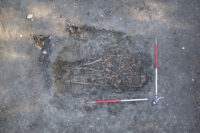 Analysis of ancient DNA has confirmed that two adult women and one perinate found in a Late Roman shared grave in Cheddington, Buckinghamshire, were mother, child and mother or aunt-in-law.
Analysis of ancient DNA has confirmed that two adult women and one perinate found in a Late Roman shared grave in Cheddington, Buckinghamshire, were mother, child and mother or aunt-in-law.
The grave was unearthed in 2018 during an archaeological survey of a site near Cheddington village that was slated for housing construction. The excavation found evidence of Late Iron Age settlement, agricultural activity and iron smelting on an industrial scale. In the western corner of the site, archaeologists found several inhumations dating to between the early 4th century and the mid-6th century A.D.
Found together inside the grave were the skeletal remains of two adult women, one older than 45 at death, the other 25-29 years old. The bones of a fetus at about 32-36 weeks gestation were found on the lower chest/abdomen of the younger woman, indicating she was either buried with her stillborn child or died while the baby was still in utero. The middle of the grave had been disturbed, likely by ploughing, causing some disarticulation of the bones and therefore making it impossible for archaeologists to determine conclusively whether the fetus was still inside the mother when she died.
The rectangular grave had been dug in one event, which means the women died within a short time of each other and were buried together for sentimental and/or practical reasons. Radiocarbon dating of bone samples from both individuals returned very similar date ranges: 255-421 A.D. for the older woman, 255-428 A.D. for the younger. Double graves were very rare in this period. Archaeological maternal deaths from any period are far rarer. Only 24 of them have ever been found in the UK.
The shared grave was found near a ditch on the periphery of the Iron Age settlement. This placement, known as a “backland burial,” is typical of small family plots in the Late Roman period. To confirm whether the two women and perinate were related, researchers extracted and sequenced DNA from all three individuals.
The results of the aDNA analysis confirmed that both adult skeletons were female, and that the foetus was male (something which could not be determined osteologically). The mitochondrial DNA from the younger female and the foetus confirmed they were mother and son. More remarkably, the older female was unrelated to the younger female but was a second-degree relative of the foetus, most likely its paternal grandmother (or alternatively, a paternal aunt).
The aDNA results confirm that the people buried together in this grave were related, and potentially were three generations of the same family who had died within a short space of time to one another. It is entirely possible that the adults were related by marriage and mother died in the late stages of pregnancy. A fascinating and poignant burial, which gives us a small window into family relationships in the past.